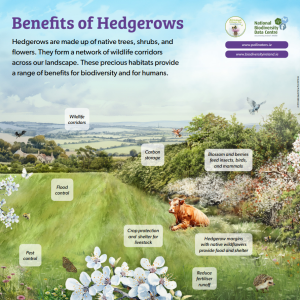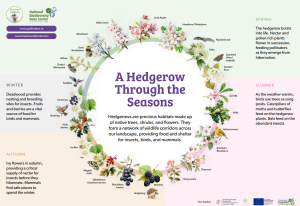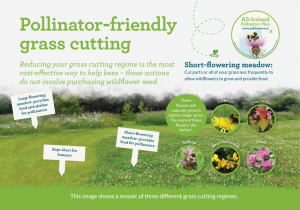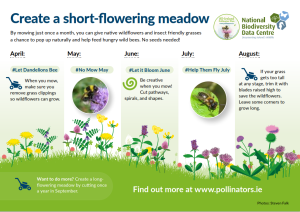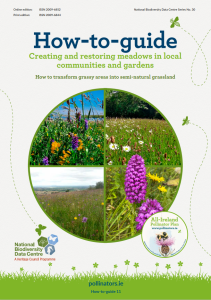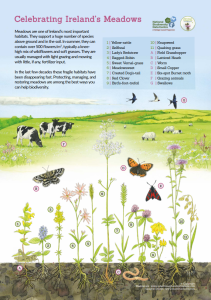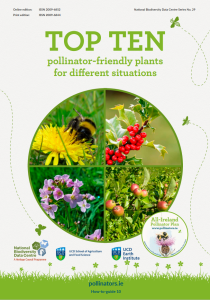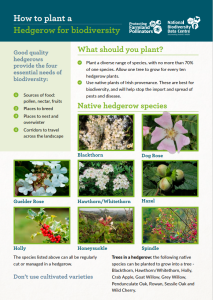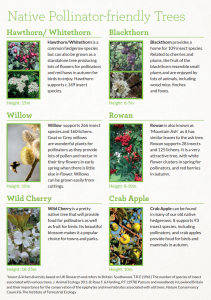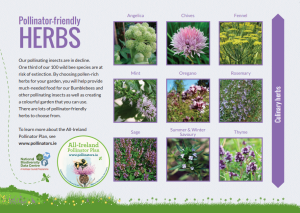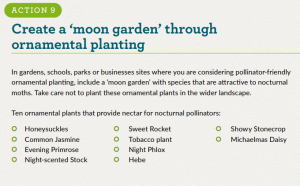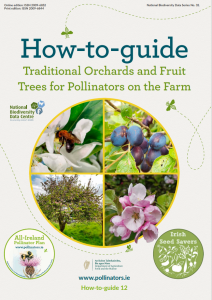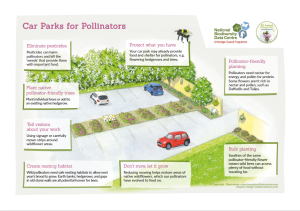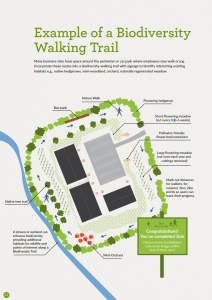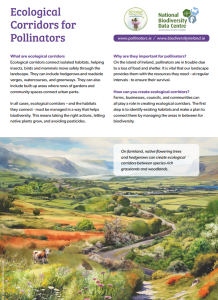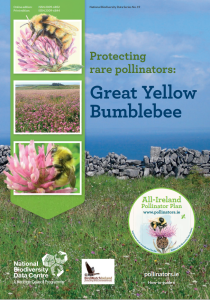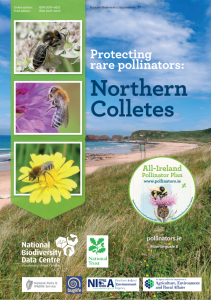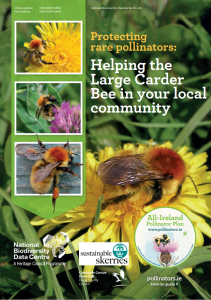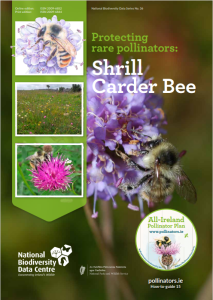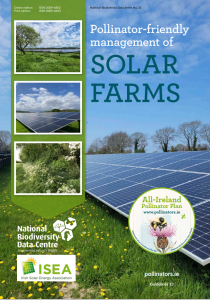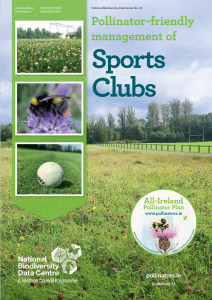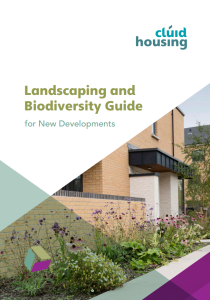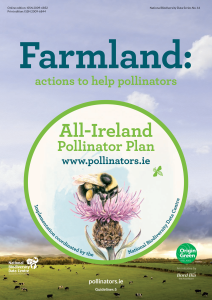Resources for business
We invite Business Supporters to follow the specific evidence-based guidelines within ‘Businesses: actions to help pollinators’ and use the companion resources to help in decision making.
COMPANION RESOURCES
The following will help inform decisions on Physical Actions (A-E) in Businesses: actions to help pollinators.
A – Protect what you have
Protect/enhance what is great already. Consider managing an existing native hedgerow or an existing native meadow area to support pollinators. N.B. Don’t get rid of an existing meadow to plant trees.
Identify which biodiversity is on or ‘adjacent’ to your site through ![]()
B – Mow less in grassy areas
Reduce mowing, AND lift the cuttings to create naturally regenerated wildflowers – a vital food source for wild bees. Include SIGNAGE (free, downloadable, print-ready) and a mown perimeter strip. Editable ‘Let it Bee’ or ‘Meadow in Progress’ signage also available to include your business logo, website URL, or QR code.
Our rare bees and how you can help in your area
- Considering a meadow? Identify specific habitat development for the Large Carder Bee.
Is your business located:
- Adjacent to coastal area/near dunes/machair (floral rich grasslands)? Consider specific habitat for the Northern Colletes.
- On the west coast (Mayo/Mullet Peninsula, north Clare, south-west Donegal and/or Connemara)? Consider specific habitat for the Great Yellow Bumblebee.
- Adjacent to The Burren/Galway? Consider specific habitat for the Shrill Carder Bee.
N.B. Sowing wildflower seed mixes to create a (mini) meadow is NOT a biodiversity action. Non-native wildflower seed mixes may contain invasive species such as Black Grass, potentially devastating for our agricultural sector. Native mixes may have a high percentage of annuals which you will need to re-sow next year! INSTEAD reduce mowing.
C – Pollinator-friendly planting (native and ornamental)
‘THEMATIC’ PLACES FOR POLLINATORS
Consider on your business site thematic planting such as a Herb (culinary and/or medicinal), Sensory, or Moon Garden for nocturnal pollinators.
Or a Heritage fruit tree orchard.
Create pollinator-friendly places within your car park as part of a Biodiversity Walking Trail. Or join with business neighbours to create an Ecological Corridor.
D – Provide nesting habitats
REMEMBER To have honeybee hives or an apiary is NOT a biodiversity action. The honeybee is a managed pollinator and not under threat. To increase numbers may create competition for food for our wild bees. An apiary is absolutely fine if part of your core business, and is a wonderful hobby. Considering installing honeybee hives? PLEASE SEEK EXPERT ADVICE from your local beekeeping association.
E – Reduce/eliminate use of pesticides
- Review alternatives to pesticides and information on Pesticide-free places. N.B. You can only say your business is Pesticide-free if you have FULLY eliminated pesticides.
- You will still need to spot-spray invasive species. Review advice at

Communication Actions
We encourage businesses to deliver communication actions based on what is helpful for our 100+ wild bees.
- Invite Employees to ‘Pledge Your Garden’.
- Leverage Suppliers to sign up to AIPP. Ensure you ‘specify’ and buy pollinator-friendly options.
- Engage with your local Community through Tidy Towns and the GAA’s Green Club Toolkit GAA Green Club – Biodiversity
- Join affiliate conservation projects such as Ponds for Biodiversity.
Track, Measure & Monitoring
- Not sure what’s on your site? Commission a baseline ecological survey from the Chartered Institute of Ecology & Environmental Management, include the National Pollinator Monitoring methodology and repeat every 5 years.
- Identify what is on and adjacent to your site through Biodiversity Maps.
- Identify how pollinator friendly your car park is using the Assessment Table (Bronze/Silver/Gold) on Page 31 of ‘Businesses: actions to help pollinators’
- Score your business through the Business (self) Scoring for Pollinators Checklist on Pages 33-35 of ‘Businesses: actions to help pollinators’ guidelines.
- Map your evidence-based actions on Actions for Pollinators (GIS).
- Record and monitor what is on your business site(s) through the formal and scientifically robust weekly Flower Insect Timed (FIT) Counts and the monthly (March-October) Bumblebee Monitoring Scheme.
- Review other biodiversity monitoring schemes and conservation projects.
CONSIDER SPECIFIC POLLINATOR-FRIENDLY PLACES
READ MORE on our endangered pollinators here: Great Yellow Bumblebee, Northern Colletes, Shrill Carder Bee and the Large Carder Bee. N.B. If you are allowing a meadow to develop then the Large Carder Bee resources may prove helpful.
SECTOR SPECIFIC RESOURCES – pollinator-friendly management
CONSTRUCTION – Housing: New Developments
Cluid’s Landscaping and Biodiversity Guide for New Developments, with biodiversity actions endorsed by the All-Ireland Pollinator Plan includes: Preplanning checklist: Habitat survey, Invasive species, Tree and hedgerow survey, Root Protection Areas (RPA), Full level survey, Sustainable Urban Drainage Systems (SuDS) etc. | Design stage | Boundary treatment selections and their impact on biodiversity | Public infrastructure to protect and encourage biodiversity | Groundworks, Hard landscaping & Soft landscaping/plants | Amenities | Make apartment balconies and private gardens biodiversity-friendly | After-care programme for landscape works.
Asset Managers (residential): provide Residents’ Associations with the new Residents’ Associations – Actions for Pollinators.
AGRI-BUSINESS/PROCESSORS and farm-suppliers/growers, evidence-based actions, monitoring and recording:
- Farmland: actions to help pollinators guidelines and Biodiversity on Your Farm recording initiative (no experience necessary).
- Processors’ supply chains (farm suppliers/growers) step-by-step to help their supply chains understand which evidence-based actions to take to support pollinators.
- Farmers’ Wildlife Calendar – help support the tracking of what is happening to biodiversity (including pollinators) in relation to climate change.
- Engage with affiliate conservation projects such as Ponds for Biodiversity.



